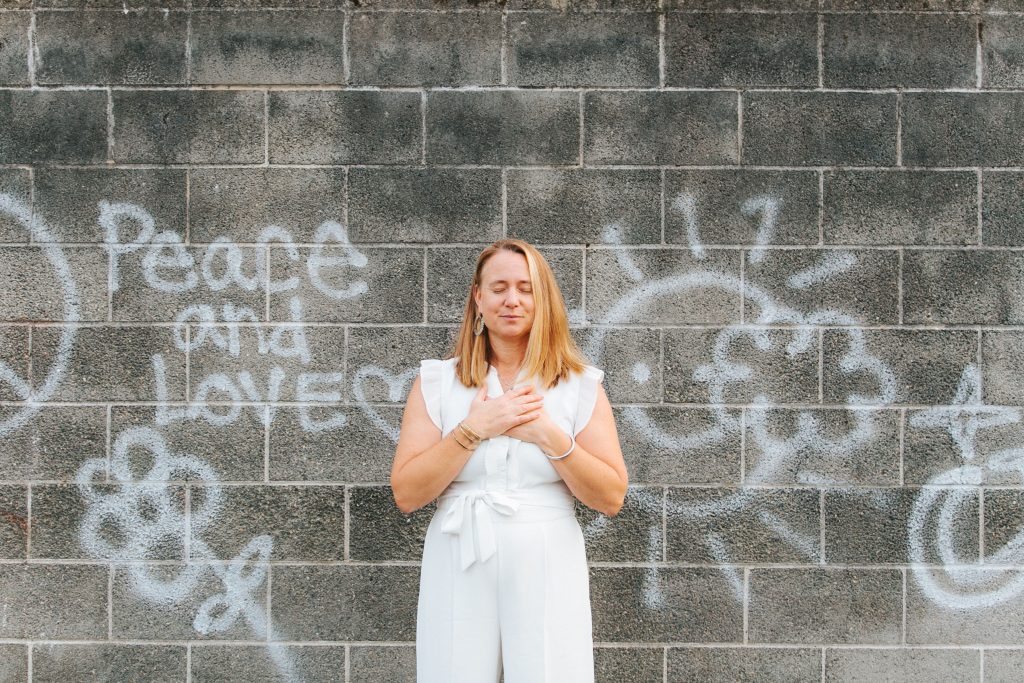In this week’s post on healing anxiety and the associated health challenges, I’m going to expand more on what I shared with you last week.
Before I begin, take 1 minute to close your eyes. Place both feet on the floor. Scan your body and notice areas of tension. Can you give that area a color? Shape? Sound? Smell? Just notice what you’re feeling. Sit with it for a moment.
My therapist, Charlie, taught me this technique. I use it when I’m feeling nervous, shut down, angry.
Throughout my life, I’ve always felt and probably taught, that ‘negative’ emotions such as fear, anger, rage, sadness were ‘bad’ and that, with intense effort, I should push those away and replace them with the rainbows and butterflies of joy, happiness, gratitude, and hope.
What I’ve learned this past year, is that, the more we can sit with our ‘negative’ or ‘bad’ feelings and give them space, allow them to share with us what they need to convey, the quicker we can genuinely move through these feelings. Charlie shared with me that ‘negative’ emotions are just like toddlers who are trying to get our attention but can’t, so they proceed to get louder and more aggressive. When all they really need is a hug and presence.
When we allow our temper-tantruming children to express their feelings, they can wipe away the tears, with our help, and move on with their days. When we allow our own inner angry feelings to have a space, this allows for them to find acknowledgement and to move on.
The above exercise of naming a color, sound, taste, shape gives focus to these feelings and allows them to be seen and heard and then they get to go on their merry way and you can get on with your day.
Experiencing the rainbow of feelings is human. In the new documentary, “Mission Joy: Finding Happiness in Troubled Times” (I highly recommend this beautiful and uplifting movie with His Holiness the Dalai Lama and Archbishop Desmond Tutu on Netflix), The Dalai Lama’s translator says that in Buddhist philosophy, the way to get through difficult times is to reframe the situation. These two extraordinary leaders embody this philosophy beautifully, given the intense times that they’ve personally been through and helped their people through.
So let’s dig into troubling times. We’ve all had them. I don’t think there’s a human on the planet who hasn’t experienced grief, loss, abuse, witnessed abuse of others. Whether you’ve personally experienced a little t trauma or a big T trauma, it’s likely that your brain stored that information in there and is holding all of the details around the incident so that it can remember how to protect you from it the next time.
Let’s take a dog bite example. Let’s say you’re enjoying your morning walk at the park and a dog comes racing toward you and bites you on the leg. It goes through your clothes, breaks your skin, there’s blood and pain involved.
Your brain, in that moment, is taking in every single detail, whether you’re conscious of it or not, of the environment. It’s noting the smells around, the colors of the trees, the dog, the jackets of the people standing around, the sound of the dog barking at you. All of this is imprinted so quickly that you’re likely not aware of it. All of that is then stored for future use.
Let’s say that after the dog bite, you’ve got to rush back to get ready for work and then have a full day. You’re not able to process what just happened. If you’ll remember in last week’s email, I quickly mentioned completing the stress cycle by dancing, laughing, talking, resting, moving.
Ironically, that dog that bit you is probably running around with his friends, followed by a good full-body shake and a rest in the sun for an hour. He gets up, rested and ready for the next attack with no thought of the trauma he just put you into.
Fast forward 3 months. You’re in the park for your morning walk again and another dog is coming at you. Even though it’s a smiling golden retriever coming over to get a head scratch, you’re brain immediately remembers the last dog that came running over to you. That trauma loop is ready to jump in and save you by kicking in the nervous system response to get you ready to fight or run away.
Now let’s say that some house nearby, at the time of the actual dog bite, was doing laundry and the detergent smell was in the air. Even though you didn’t notice at the time, your brain did. If you didn’t complete the stress cycle after the dog bite, the smell of that detergent may ignite a stress response for you seemingly out of nowhere. You start to feel anxiety for no reason that you can comprehend.
What’s actually happening is that your brain is storing any and all of the sensory information from that dog bite incident and will take any environmental cues from the time and use those to keep you out of dangers’ way. This could also include the orange puffy jacket of person standing to the side, witnessing the attack. In the future, orange could potentially create some discomfort for you.
While I’m using this as an example, I hope it gets the point across.
When you experience traumatic or stressful events, your brain is processing everything going on around. This can be a lifetime memory. When there are dozens of these events, which I think most people do, over a lifetime, your brain stores all of the information and when this becomes so full, it creates so many triggers that your brain responds to.
How to start changing those patterns
It’s important to remember that anxiety is (usually) a culmination of multiple events.
As I mentioned above, either one ‘Big T’ or multiple ‘little t’ traumas can create a trauma loop that, if left unchecked, can lead to low-grade fight-or-flight patterning.
I find that, personally, I get better results with healing anxiety by working on it as I would with any other health condition: it’s a slow and steady with everyday attention process to make changes. Same as if I were healing sleep, an injury, or a disease process. It’s not over with taking a pill. Baby steps, done daily are required to change habits. Because, yes, anxiety is a habit that the brain has formed over time and needs to change.
I find that it’s better to do the work when I’m not in the middle of a panic attack or major anxiety. One of the greatest help I had was after I broke my arm and had days and days of not being able to do much of anything except sit.
I discovered the Transforming Anxiety Podcast and listened almost daily. One of the things that I learned is that long, deep breathing in and out through the nose, 15 minutes a day, regulates the central nervous system. And, hey, since I had tons of time, I started practicing this 3 times a day. I felt huge shifts with some of the symptoms that were still lingering around.
So, remember your breath. It’s a huge healing factor. It’s free. It’s easy. You can do it anywhere.
Next, when your mind starts to veer toward old scripts that keep you or remind you of an old pattern that isn’t moving you into a positive direction, remember that you have the power to change those thoughts. As you’ve probably experienced, your thoughts will and do create physiological changes. You don’t have to be directly experiencing an event for it to quicken your heart rate, breathing rate, and slow down digestion. Just the thought of it can do the same.
When you start to play an old reel in your head, you have some options:
1. Tell yourself to ‘stop, stop, stop’
2. Start dancing
3. Replace that thought with a happy or joyful memory
4. Move
Do anything to replace those thoughts that are auto-pilot.
And I’m going to repeat exactly what I wrote in last week’s post because I really feel like it can be said over and over. I still need to remind myself of it, as well:
Healing anxiety, depression, chronic pain, fatigue require a multi-pronged approach. There is no one answer for anyone for any condition. It requires attention, patience, curiosity, and willingness to make life changes.
Some Tools You can Use…
- Dr. Joe Dispenza’s meditations, along with his book Becoming Supernatural have been uber-helpful with the worry, pressure and stomach tightness I used to experience all the time for many years. I purchased his course and practiced the work and meditations for about 2 years. The link above is to an interview with him that inspired me to purchase the course.
- The Dynamic Neural Retraining System with Annie Hopper took me to the next level. I was still having anxiety-related sleep issues and muscle jerking throughout the night and this program helped me within 2 days of practicing it.
- Moving away from anxiety-producing relationships. I thought I needed to stay on good terms with all people and lived this philosophy my whole life, until about 6 years ago. Mean people are mean and I don’t (and you don’t) need them in my life. If there are people in my life who are constantly chaos-producing, anxiety-invoking for me, they’re gonners. This has pretty much been the biggest game changer with the anxiety. Addendum: EVERY relationship has it’s ups-and-downs and I don’t expect every interaction to be filled with rainbows and butterflies, but if I lost nights of sleep over certain people, I made this my barometer to make the decision to move along.
- Long Deep Breathing 15 minutes a day, sometimes 2-3 times a day.
Are you a teacher? I’m so grateful for your hard work and I want to offer you a Teacher Appreciation discount. When you schedule for either an in-person, hands on treatment or a life/health coaching appointment, you’ll receive a 20% discount.
Military? Same goes for you. I appreciate you and want to offer you a 20% discount as well.
Whatever your situation, there’s no reason not to get the care you’re looking for. If you’re ready to make those changes, I’d love to work with you! Schedule your appointment today.
Remember that healing is a journey, not a destination. Every little step you take toward your own healing, becomes a step toward empowerment and making a life for yourself that you can love and live freely.
I’m here to help you along that journey and appreciate the opportunity to be a part of that.
Always, in healing,
Dr. Arjan



